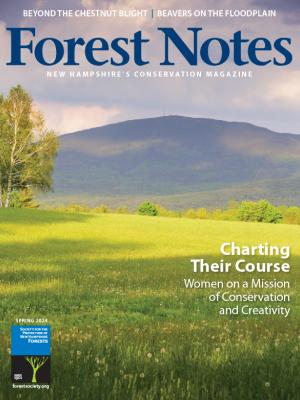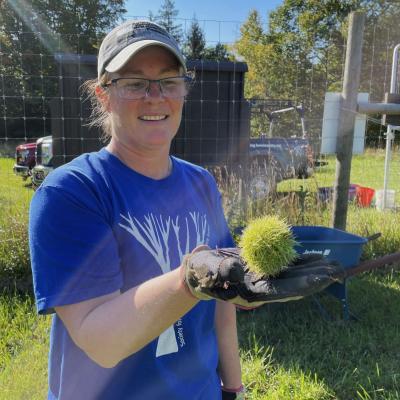- Tags:
- Forestry,
- Volunteers

The American chestnut trees pictured in 2021.
This article was originally printed in the spring 2024 issue of Forest Notes magazine.

American chestnut (Castanea dentata), once a stately and dominant tree in deciduous forests of the Northeast, now rarely grows larger than an understory sapling. At fault is the invasive blight fungus (Cryphonectria parasitica), which causes cankers on the cambium tissue under the chestnut bark that quickly girdle and kill infected trees. Restoration of the American chestnut to any semblance of its former grandeur on our landscape is a complex and arduous challenge, but one that The American Chestnut Foundation (TACF) has embraced fully and has been working toward for more than four decades.
Since 2019, the Forest Society has worked collaboratively with the Vermont/New Hampshire Chapter of TACF to maintain an American chestnut seed orchard at the Tom Rush Forest in Deering, N.H. To establish the orchard, we enclosed one acre of an existing field with 8-foot-tall deer fencing and, with the help of volunteers, planted 600 nuts in May 2019.
These chestnuts were hybrid backcrosses with Chinese chestnut (Castanea mollissima), which is resistant to the chestnut blight fungus. The hope was that a few of these hybrid trees (which are 15/16th American chestnut and 1/16th Chinese chestnut) might end up resistant to the blight. Nearly all the 600 nuts sprouted, and, thanks to careful watering, weeding, fertilizing, and mowing by orchard volunteers, most grew and thrived for the first four years.
“The survival and subsequent care of the trees at the Tom Rush Forest chestnut orchard has been exemplary,” notes TACF Director of Regional Programs Kendra Collins. “It’s so wonderful to see the trees thrive through the implementation of best management practices and regular care by the volunteers.”
The Forest Society’s original plan in spring 2023 was to inoculate all the trees with the blight fungus when they reached 5 years of age, kicking off a sort of sylvan Hunger Games to hasten the process of determining which individuals were blight resistant. But the interesting thing about scientific research is that it is always evolving and changing based on the latest available data and protocols. Hence, TACF’s new directive later that summer which was to not prematurely infect the trees with the hope that a few end up significantly resistant to blight, but rather do everything we can to keep a select subset of the trees healthy as long as possible and help them reach breeding maturity.
This was welcome news for our chestnut volunteers, who weren’t looking forward to infecting the trees after spending countless hours tending to them.
In fall 2023, volunteers found a spiny chestnut bur housing up to 3 chestnut seeds. This exciting discovery tells the Forest Society that the trees are very close to breeding maturity.

Moving forward, the orchard’s trees will be used essentially as “breeding stock” and will be pollinated with pollen from the most blight-resistant trees TACF has developed or identified, resulting in nuts that will have increased genetic diversity.
Of the original 600 chestnuts planted in 2019, 60 trees remain in the orchard. This drop-off occurred in summer 2023, not because of the chestnut blight, but because the orchard was deliberately thinned to keep only the largest and healthiest looking trees and ensure they have ample room to grow. These trees are growing and thriving, with many measuring more than nine feet tall!
The next exciting chapter for the Tom Rush orchard involves planting more chestnut trees later this year. The VT/NH chapter of TACF, in partnership with other similar chapters in the Northeast, has several hundred chestnuts available that were produced in New England by crossing their most resistant varieties to date.
Tools to uncover blight resistance, such as genetic sequencing, have become much more sophisticated since the 2019 planting, so these nuts will be started in pots in greenhouses and their DNA will be analyzed for genetic markers known to convey at least some blight resistance.
“This is an exciting evolution of our process,” Collins says. “It allows us to select promising trees without the added stress of stem inoculations.” Only the most promising seedlings, likely fewer than 30, will be chosen for planting at Tom Rush Forest in fall 2024.
Orchard volunteers, including Kay Hartnett of Deering, will be ready to plant when the time comes.
“It gives me hope the work we are doing might bring back the chestnut tree,” she says. “I’m pretty sure I won’t be around to see the real fruits of our work, but I am proud to be a part of the beginning of this experiment, and hope it ends with repopulating the forests with these trees.”
Carrie Deegan is the Reservation Stewardship & Engagement Director for the Forest Society.
Learn more:
Retooling Chestnut Tree Restoration Efforts
Forest Notes readers may be familiar with the recent news about The American Chestnut Foundation’s (TACF) retraction of support for the genetically engineered chestnut variety Darling 58 (D58) that the State University of New York College of Environmental Science and Forestry developed, and which is currently under review for de-regulation by the USDA and EPA. D58 contains a wheat gene scientists hoped would convey blight resistance, but TACF ultimately rejected it due to poor performance issues in successive generations.
Forest Society chestnut trees at the Tom Rush Forest orchard are not D58 or genetically engineered plants; neither are the trees slated for planting in fall 2024. TACF still believes that genetic engineering holds promise as one approach in their goal of restoring the American chestnut, but it is only one strategic avenue out of many. The Tom Rush Forest orchard and other seed and stock orchards like it represent another key approach to working toward blight resistance. “The new planting at Tom Rush Forest is part of the next evolution of breeding at TACF and we’re really excited to push forward with better selection tools and modeling capabilities,” TACF Director of Regional Programs Kendra Collins says. “I’m thrilled to have the Forest Society team supporting this revamped effort on such a successful site. Organizations like the Forest Society understand working on ‘tree time,’ as well as the need to pivot when science presents us with better tools or solutions. We really appreciate their partnership in our work to restore the American chestnut.” As staff and volunteers have already experienced in their few short years of tending the orchard, management plans will continue to evolve and change in the future with new and improving science, which is all part of the fun!
